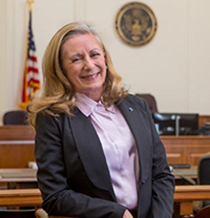By: Lynn Welter Sherman, Trenam Law
I caught up with Chief Judge Laurel M. Isicoff on President’s Day via Zoom. Although her virtual background was her official courtroom background, she confessed she was in her backyard working on “non-billable matters” (defined as anything other than official Bankruptcy Court business). On this particular afternoon, she was creating materials for a new financial literacy program geared to veterans. After a few minutes of COVID small talk (haircuts, vaccines, and visiting grandchildren), we got down to my list of questions for the BLS Women’s History Month interview.
The decision to become a lawyer
Chief Judge Isicoff always wanted to be a lawyer because her grandfather, who she adored, was a lawyer. While in college at Barnard, she change her mind and decided to major in Spanish and become a Spanish teacher. After graduating from college, she took a year off, took the LSAT, and started law school at NYU in 1979. [A little known fact: she and Bankruptcy Judge Mora were in the same 1L class at NYU, but did not know each other because they were assigned to different sections.] After her 1L year, she transferred to the University of Miami law school to be near her then fiancé/now husband, Steven Isicoff. She graduated in the top of her class from UM in 1982.
The path to the bench
In 1982, many law firms were reluctant to hire female associates, regardless of their stellar credentials. The explanation was that the firm would invest time and money into training a female associate, who would then leave the firm to have babies. Luckily, a friend called Judge Isicoff to let her know that Judge Daniel S. Pearson of the Third DCA was looking for a law clerk. She applied and got the clerkship, which paid a whopping $13,000 annual salary.
In fact, she did get pregnant after she accepted her clerkship offer, but before she took the bar exam. Judge Pearson took the news of Judge Isicoff’s pregnancy well. So, after having her first child and taking her allotted 2 weeks (this is not a typo) of paid maternity leave, she was back to work.
After her two-year clerkship ended, Judge Isicoff accepted a position at the Miami office of Squire Sanders & Dempsey. As an associate, she worked on a variety of matters, one of which was a bankruptcy matter with a partner from the Cleveland office, Chris Meyer. While at Squire Sanders, Judge Isicoff had her second and third children (this time with 3 months of paid maternity leave).
Like many professional women in the 80’s, Judge Isicoff found it impossible to be a super mom and a super lawyer. After having her third child, she left Squire Sanders to spend more time with her children—with the intention to “retire.” Ultimately, she returned to Squire Sanders part time following an 18-month hiatus.
After 8 years at Squire Sanders, Judge Isicoff joined Kozyak Tropin & Throckmorton part time, where her practice was 100% bankruptcy and creditors’ rights. The Kozyak firm was very progressive when it came to accommodating female lawyers with children, and she ultimately returned to full-time practice at KTT.
Judge Isicoff always believed that the pinnacle of a legal career is to become a judge. So, in 2006, she became the first female Bankruptcy Judge in the Southern District of Florida, and in 2016 the first female chief judge of the district. In fact, she was the only female Bankruptcy Judge in the Southern District of Florida until 2018, when Judge Mora was appointed to the bench.
Notable mentors
Judge Isicoff was lucky to have found a number of wonderful mentors during her legal career. Judge Pearson and his wife, Judge “Ricky” Smith, were early friends and mentors. Judge Isicoff was sworn in wearing one of Judge Pearson’s robes (after serious alterations).
Chris Meyer at Squire Sanders introduced her to her first bankruptcy case, and encouraged her to specialize in bankruptcy and creditors’ rights. John Kozyak and Chuck Throckmorton were both mentors during her 14 years at KTT.
The reality of being a Bankruptcy Judge
As bankruptcy lawyers, we all have preconceived notions about what it would be like to be a Bankruptcy Judge. Judge Isicoff told me that almost everything about being a Bankruptcy Judge was different than she anticipated.
While she was right that she would have more time to think about pure legal issues, she did not fully appreciate the extent of the administrative and “back office” duties of being a bankruptcy judge. For example, the National Conference of Bankruptcy Judges functions much like a voluntary bar association, with committees that meet regularly and work on projects throughout the year [and here we all thought the NCBJ was all about having an annual party for bankruptcy judges and professionals!].
Advice to young female lawyers
Like many super-successful female professionals (think RBG, Shonda Rimes, Jane Fraser, and Oprah, to name a few), Judge Isicoff ascribes to the view that “you can have it all, just not all at the same time.”
Advice to all lawyers
Always be professional and courteous to counsel and the Court. You only have one reputation—guard it and preserve it because it is your most valuable commodity.
Advice to aspiring bankruptcy judges
You don’t necessarily need to have a bankruptcy background to become a bankruptcy judge. There are many bankruptcy judges who have had little or no bankruptcy experience before coming on the bankruptcy bench.
My two cents
Interviewing Chief Judge Isicoff was like a trip down memory lane. I graduated from law school in 1983, and my experiences with law firms, trying to find child care, working part time (cramming 40 hours into 3 days), and trying to be super-lawyer and super-mom were much the same as Judge Isicoff’s. Thankfully, law practice for women has changed dramatically since the early 80’s, in large part because of trail blazers and role models like Chief Judge Isicoff.




